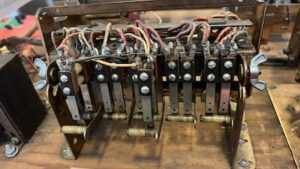
EM (electro mechanical) pinball machines use relays for just about everything. When they fail, the machine cannot work correctly.
Failure can be a relay that sticks on. Hint: that is not due to magnetism. It is due to a worn plate.
Or the contacts on the relay will stop working.
Fixing Electro Mechanical (EM) Pinball Relays
Parts Needed
-
-
-
- Switch Adjusting Tool.
- Screwdriver – multi type is fine. Slotted and (sometimes) Phillips.
- 91% Isopropyl Alcohol. Not rubbing alcohol. Higher than 91% is not needed.
- Q-tips.
- Small rubber bands – random sizes.
- A Sharpie or similar. Fine tip.
- Dremel or similar.
- Needle nosed pliers (or similar).
- Magnetic dish to hold parts. 4″ or 6″ are common.
- Towel to catch dropped parts.
- Small rubber bands – to hold the switch stacks.
And one or more of the following:
- Dremel polishing wheel .
- 1/8″ Carbon Steel Brush 443 for Dremel. Highly recommended.
- Dremel Sanding Brush Wheel (flap wheel).
-
-
The best source of EM parts is The Pinball Resource.
Removing the Pinball EM Relay
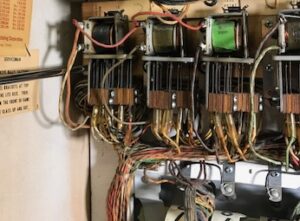 The relay could be on a bank (see photo above), in the backbox or in the cabinet.
The relay could be on a bank (see photo above), in the backbox or in the cabinet.
In almost all cases, the relay are held in place by an easy to remove retaining clip.
Before proceeding, if working in the backbox, put down a towel over the hole to the cabinet. That is to catch dropped parts.
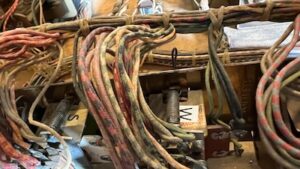
Reach in with needle nosed pliers and pull out the retaining clip and set it in your magnetic dish.
Note how the clip goes through the small hole in the relay bracket after it is slid into place.
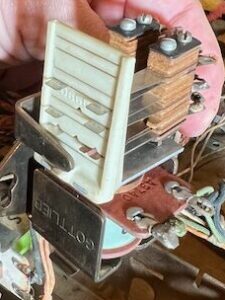 You can how hold the relay in your hand. It is connected to a bunch of wires. Most go to the switch(es) that the relay moves. There is also a pair that goes to the relay coil. Check to insure that those wires are connected and securely soldered in place. If one or more is broken or about to break, make a note of where it goes. You don’t want to have multiple wires fall off this relay and not know where they go.
You can how hold the relay in your hand. It is connected to a bunch of wires. Most go to the switch(es) that the relay moves. There is also a pair that goes to the relay coil. Check to insure that those wires are connected and securely soldered in place. If one or more is broken or about to break, make a note of where it goes. You don’t want to have multiple wires fall off this relay and not know where they go.
On many relays, there is a plastic plate like shown on this photo. The switch leafs insert into that plastic link at specific slots that may differ on each relay.
Disassembling the Pinball EM Relay
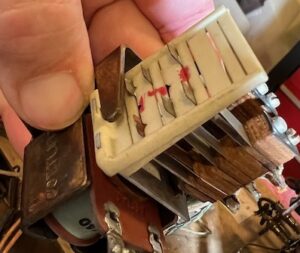
We will remove the switches. It is crucial that they are returned to the same slots. We mark the slots.
Remove each switch stack by loosening the two screws. As we take the switch stacks off, we wrap the area around the screws with a rubber band.
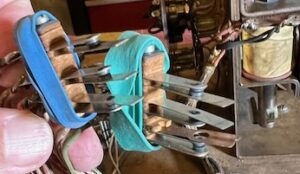
While the switch stacks hold together pretty well, we have had a few separate out. Getting them back together is better avoided.

Observe how that plate (connected to the spring) is installed. Note that there are ‘leg(s)’ on one end of that plate that must be in the slots on the bracket. That plate pivots on those slots.
Remove the spring and set the spring in your magnetic bowl. Remove that plate. [Note that the following can be accomplished without removing the spring and plate, but we find it easier to remove it.]
If your relay is sticking on, it is that plate that must be ‘repaired’. It is not magnetism.
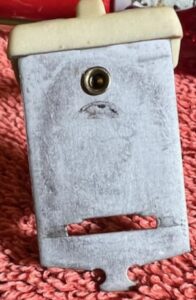
Here is the part of the plate that makes contact with the coil in the relay. Note that this plate has a single leg at the bottom. Some have two.
The damage here is relatively minor but must be smoothed out.
The bottom of the coil will stick into any indents in this plate and then not ‘let go’.
Wipe down the plate with isopropyl alcohol.

Pull out your Dremel and that 1/8″ Carbon Steel Brush 443 and get to work.
After cleaning up with the Dremel and the carbon steel brush, the bottom of the plate should look like this.
Now it will not ‘stick on’ when the relay turns off.

You should also clean up the edges of the plate. This can be done with the Dremel flap wheel.

There is a screw holding the coil onto the plate. Note the position of the screw in the relay as well as anything with that screw such as a lock washer, or tab. It has to go back the same way.

Loosen but do not remove that screw. Slide the coil out of the plate.
Next, do the same treatment with the Dremel and the carbon brush to the bottom of the relay, the metal core only.
This will remove any burrs or jagged metal edge that would damage the plate again.

Clean the switch contacts. First clean q-tips and isopropyl alcohol.
Then with the Dremel, the carbon steel brush and / or the polishing wheel, clean the contacts until they look perfectly clean. It maybe wise to clean again with isopropyl alcohol.
Reassemble the Pinball EM Relay
Everything should be cleaned and ready to go. The following steps maybe (or maybe not?) changed in order.

1) Insert the coil back all the way into the slot with the screw. Tighten down the screw holding the coil in place.
Note that in this photo, there is a bracket to hold the relay in place. This must be positioned the same way as it was originally.
2) Insert the plate into place. Make certain that the ‘legs’ of the plate are in place as well as any plastic bracket to hold the leaf switches. The plate swivels on those leg(s).
3) Reattach the spring.

4) If more than one stack of switches, do this one at a time. Remove the rubber bands around the switches. Position the switches.
For those where the switches go into a slotted plastic plate, the position of those switches is crucial!
5) Using the two screws, attach the switch stack back onto the plate, insuring that the ends of the switches stay in the proper position.
Adjusting the Switches
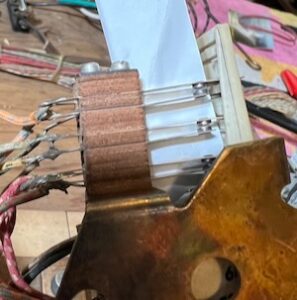
Prior to starting this section, read carefully the section on how to adjust leaf switches. Bending the leaf improperly can ruin these switches.
If the switches do not open and close, the relay will not be working properly.
The switches must be open, then close. Or be closed and then open. Plus, importantly, the face of the moving switch must ‘wipe’ across the other switch. This helps to keep the switch clean.
To make this more visible, we put a piece of white paper behind the switches.
In the first photo, the relay is off. All switches are open as shown by a space between the contacts.
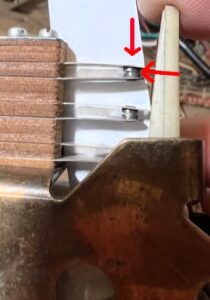
To simulate closing of the switches, press down lightly on either the plate, or the nylon plate holding the leaf switch ends.
Watch the switch contacts carefully as they close. First, the switch will move down and make contact.
After just making contact they should move slightly to one side. That is the ‘wipe’ step. If they do not wipe, then the switches have to move closer when at rest – but not so close that they touch.
Remember to follow the rules on adjusting these switches. Never use anything other than a switch adjusting tool. Bend near where the switch stack starts.
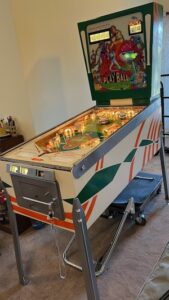 Once you are satisfied that the switches move properly, reinstall the relay into its proper location. Be sure to use the clip to hold it in place.
Once you are satisfied that the switches move properly, reinstall the relay into its proper location. Be sure to use the clip to hold it in place.
In our case, the second base relay was never turning off. Now it does and Play Ball plays perfectly.
A special thanks to Nic Schell, EM genius extraordinaire of the Roanoke Pinball Museum.
Comments
Comments, including suggestions, improvements, errors, etc. are welcome (see below).
If you have a specific question about your game that does not directly apply to this page, please see our FAQ section.